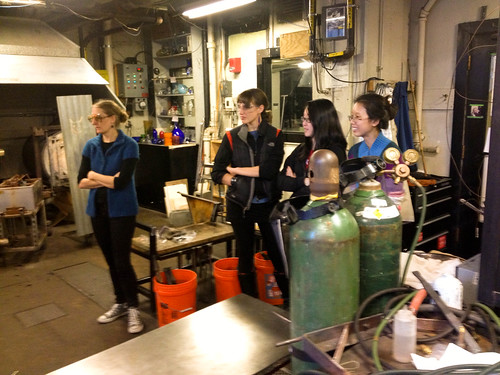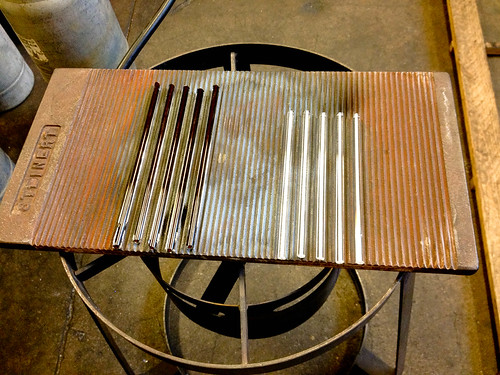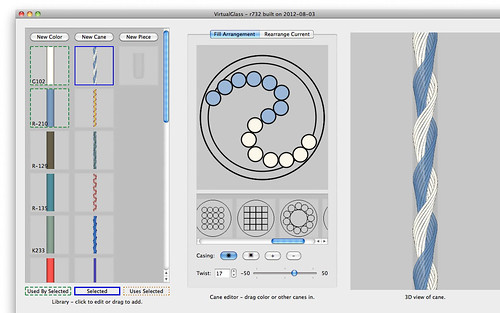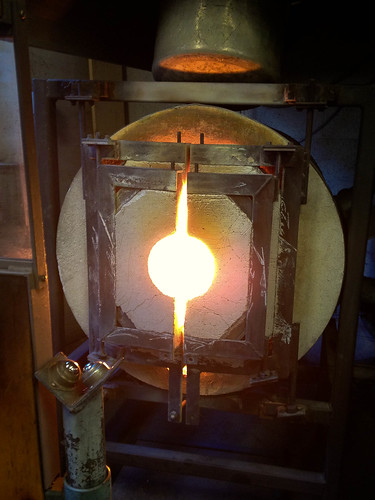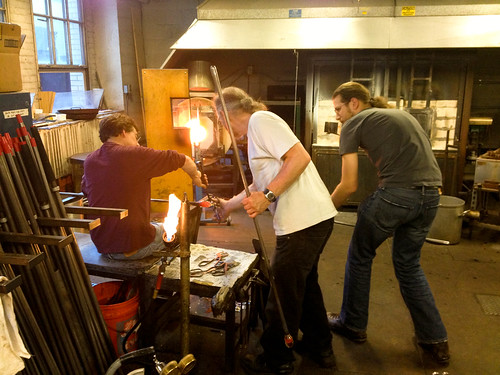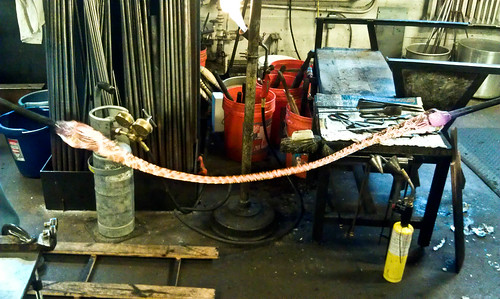2015-03-02 21:47:19 : Updating layout for new blocks.
»
Find 3a8c3faf3cf2ac8144b1050f4c387551018b567b on GitHub.
Updating layout for new blocks.
thumbnail: glass-1.jpg
track: True
---
{+{% block post %}+}
A venture-some crew headed down to the [MIT Glass Lab](http://web.mit.edu/glasslab/) last week for a demonstration of [caneworking](http://en.wikipedia.org/wiki/Caneworking).
{% mark excerpt %}
@@ -42,9 +43,5 @@ I really wish this was in focus, but alas. This is molten glass being stretched
The finished cane came out pretty cool too, though I think, more subtle than we had hoped. This is part of the end, that they let me take home after it had annealed. The finished cane--even, pencil-long sticks--will be used in blowing a larger, finished piece.
{{ macros.render_figure('<a href="http://www.flickr.com/photos/samjacoby/8252044655/" title="High-Low Tech visits the MIT Glass Lab by s_jacoby, on Flickr"><img src="http://farm9.staticflickr.com/8347/8252044655_5e42c65c15.jpg" width="500" height="172" alt="High-Low Tech visits the MIT Glass Lab"></a>', "Ooooo.")}}
{+{% endblock %}+}
2015-02-16 14:28:44 : Adding excerpts to all posts, basically.
»
Find 07a57fe3ebb846616f1ae7d0aa3cfbc0f1920d57 on GitHub.
Adding excerpts to all posts, basically.
---
A venture-some crew headed down to the [MIT Glass Lab](http://web.mit.edu/glasslab/) last week for a demonstration of [caneworking](http://en.wikipedia.org/wiki/Caneworking).
{+{% mark excerpt %}+}
The Glass Lab is something apart at MIT. Less lasers, more 15th-century Italian glassblowing. I'd assumed that it was a hold-over from the days when chemistry departments blew their own glass and the like, but I believe it comes from the materials' science department, or some such. There is a much coveted lottery every semester, where a lucky dozen or-so get a chance to learn the craft. I've missed every opportunity, alas.
{+{% endmark %}+}
{{ macros.render_figure('<a href="http://www.flickr.com/photos/samjacoby/8252047247/" title="High-Low Tech visits the MIT Glass Lab by s_jacoby, on Flickr"><img src="http://farm9.staticflickr.com/8063/8252047247_dbf63a22e6.jpg" width="500" height="375" alt="High-Low Tech visits the MIT Glass Lab"></a>', "The gang, skeptical.") }}
2013-01-29 18:40:51 : Start displaying .git tracking information
»
Find cfa46ecb8a0244c3a1d4650cff13dc9294381b44 on GitHub.
Start displaying .git tracking information
date: 2012-12-04 17:05:59
keywords: high-low tech, mit, glass lab, cane, virtual glass
thumbnail: glass-1.jpg
{+track: True+}
---
A venture-some crew headed down to the [MIT Glass Lab](http://web.mit.edu/glasslab/) last week for a demonstration of [caneworking](http://en.wikipedia.org/wiki/Caneworking).
2012-12-09 12:11:05 : Keep on tweaking.
»
Find 6929b597d4488f7fe6b44824da02b334d59aaff6 on GitHub.
Keep on tweaking.
---
A venture-some crew headed down to the [MIT Glass Lab](http://web.mit.edu/glasslab/) last week for a demonstration of [caneworking](http://en.wikipedia.org/wiki/Caneworking).
The Glass Lab is something apart at MIT. Less lasers, more 15th-century Italian glassblowing. I'd assumed that it was a hold-over from the days when chemistry departments blew their own glass and the like, but I believe it comes from the materials' science department, or some such. There is a much coveted lottery every semester, where a lucky dozen or-so get a chance to learn the craft. I've missed every opportunity, [-unfortunately. Alas.-]{+alas.+}
{{ macros.render_figure('<a href="http://www.flickr.com/photos/samjacoby/8252047247/" title="High-Low Tech visits the MIT Glass Lab by s_jacoby, on Flickr"><img src="http://farm9.staticflickr.com/8063/8252047247_dbf63a22e6.jpg" width="500" height="375" alt="High-Low Tech visits the MIT Glass Lab"></a>', "The gang, skeptical.") }}
@@ -18,9 +18,11 @@ Anyhow, [Peter Houk](http://web.mit.edu/glasslab/peeps_pbhouk.html) presented so
Erik gave us a quick demo--though the software is fairly self-explanatory, especially after you've seen the cane made--and we came up with a number of designs of varying degrees of practicality. The point, really, was to push the designs as far as we could go--and see what kind of things Peter, Marty, & Erik could put together. This is what I came up with:
{+Peter was pushing us to make 'unconventional' designs, as the last innovations in cane configurations were by an Italian dentist a half-century ago. It's harder than it might seem. Because the hot glass is twisted as it is pulled into cane, patterns converge very quickly on helices, no matter how loopy your layout. The only real tool you have, then, as a designer, is the distance of each color each color from the center.+}
{{ macros.render_figure('<a href="http://www.flickr.com/photos/samjacoby/8253121374/" title="High-Low Tech visits the MIT Glass Lab by s_jacoby, on Flickr"><img src="http://farm9.staticflickr.com/8065/8253121374_f649ef3764.jpg" width="500" height="313" alt="High-Low Tech visits the MIT Glass Lab"></a>', "The [Virtual Glass](http://virtualglass.org) software and my squiggly design.")}}
[-The main tool that you have is the distance of each color from the center.-]When a piece of hot glass is pulled out and spun--I'm sure this process has a lovely Italian name that I don't know--the colors [-rotate around the axis-]{+are stretched+} in concordance to how far they are from the center. Colors near the center of the cane show hardly any rotation at all--a vague waver, maybe. Those towards the edge wrap around [-dramatically.-]{+dramatically, pulled around the entire circumference.+} In using a spiral design, the distance of the various canes from the center of the larger cane varied in a way that seemed pretty cool.
{{ macros.render_figure('<a href="http://www.flickr.com/photos/samjacoby/8252050895/" title="High-Low Tech visits the MIT Glass Lab by s_jacoby, on Flickr"><img src="http://farm9.staticflickr.com/8488/8252050895_964870d1d5.jpg" width="375" height="500" alt="High-Low Tech visits the MIT Glass Lab"></a>', "Fearsome flame fires.") }}
2012-12-09 01:11:10 : Hrm.
»
Find 154e1e41d66baee6893ca31c00a4621ff5837aae on GitHub.
Hrm.
keywords: high-low tech, mit, glass lab, cane, virtual glass
thumbnail: glass-1.jpg
---
A venture-some crew headed [-off-]{+down to+} the [MIT Glass Lab](http://web.mit.edu/glasslab/) last [-week. In the basement, off've-]{+week for a demonstration+} of [-the Infinite--or more accurately, directly below the Infinite, the-]{+[caneworking](http://en.wikipedia.org/wiki/Caneworking).+}
{+The+} Glass Lab is [-an odd corner of things over here.-]{+something apart at MIT. Less lasers, more 15th-century Italian glassblowing.+} I'd assumed that it was a hold-over from the days when chemistry departments blew their own glass and the like, but[-it's apparently not.-] I [-forget the details, but it's folded into-]{+believe it comes from+} the [-materials-]{+materials'+} science department, [-I believe.-]{+or some such.+} There is a much coveted lottery every semester, where a lucky dozen or-so get a chance to learn the craft. I've missed every opportunity, unfortunately. {+Alas.+}
{{ macros.render_figure('<a href="http://www.flickr.com/photos/samjacoby/8252047247/" title="High-Low Tech visits the MIT Glass Lab by s_jacoby, on Flickr"><img src="http://farm9.staticflickr.com/8063/8252047247_dbf63a22e6.jpg" width="500" height="375" alt="High-Low Tech visits the MIT Glass Lab"></a>', "The gang, skeptical.") }}
2012-12-07 23:27:35 : Tweaks, home.
»
Find 2ed01935bceee5b6442dcecff2aa7fcc7d0dc68b on GitHub.
Tweaks, home.
keywords: high-low tech, mit, glass lab, cane, virtual glass
thumbnail: glass-1.jpg
---
A venture-some crew headed off the [MIT Glass Lab](http://web.mit.edu/glasslab/) last week. In the basement, off've of the Infinite--or more accurately, directly below the Infinite, the Glass Lab is an odd corner of [-things.-]{+things over here.+} I'd assumed that it was a hold-over from the days when chemistry departments blew their own glass and the like, but it's apparently not. I forget the details, but it's folded into the materials science department, I believe. There is a much coveted lottery every semester, where a lucky dozen or-so get a chance to learn the craft. I've missed every opportunity, unfortunately.
{{ macros.render_figure('<a href="http://www.flickr.com/photos/samjacoby/8252047247/" title="High-Low Tech visits the MIT Glass Lab by s_jacoby, on Flickr"><img src="http://farm9.staticflickr.com/8063/8252047247_dbf63a22e6.jpg" width="500" height="375" alt="High-Low Tech visits the MIT Glass Lab"></a>', "The gang, skeptical.") }}
@@ -22,11 +22,11 @@ The main tool that you have is the distance of each color from the center. When
{{ macros.render_figure('<a href="http://www.flickr.com/photos/samjacoby/8252050895/" title="High-Low Tech visits the MIT Glass Lab by s_jacoby, on Flickr"><img src="http://farm9.staticflickr.com/8488/8252050895_964870d1d5.jpg" width="375" height="500" alt="High-Low Tech visits the MIT Glass Lab"></a>', "Fearsome flame fires.") }}
At any rate,[-the-] Team Glass Lab decided to [-made-]{+make+} it happen. There was only about a half-hour, [-but somehow, they made it happen.-]{+so time was tight.+} It was quite a show. In corner one, we've got dual furnaces, each heating a white-hot pool of glass. In [-the corner,-]{+corner two,+} a [-glory-hole ---]{+glory-hole,+} an insanely-hot furnace in which dabs of glass are reheated and heated when on the end of an uh...punty? I may have made that {+term+} up--a long metal rod, at any rate. A blowtorch is off in the corner, braying its firey mess. (For some additional anthropological thoughts on the subject, please see: _[Conner, Erin, Embodied Knowledge in Glassblowing: the experience of meaning and the struggle towards proficiency](http://www.google.com/url?sa=t&rct=j&q=&esrc=s&source=web&cd=1&cad=rja&ved=0CDgQFjAA&url=http%3A%2F%2Fwww.scasss.uu.se%2FIIS2005%2Ftotal_webb%2Ftot_html%2Fpapers%2Fembodied_knowledge.pdf&ei=mR7CUPSeOLGG0QHL0IHICA&usg=AFQjCNEurTuRIijIgxjSkvYBr88V9uoA7g&sig2=OtTGICr3kqIYG77wUhMrdQ)_. I read this paper for a class on qualitative ethnography last year. Smutty stuff.)
{{ macros.render_figure('<a href="http://www.flickr.com/photos/samjacoby/8253115392/" title="High-Low Tech visits the MIT Glass Lab by s_jacoby, on Flickr"><img src="http://farm9.staticflickr.com/8208/8253115392_20b5c1662a.jpg" width="500" height="375" alt="High-Low Tech visits the MIT Glass Lab"></a>', 'Something critical taking place.')}}
Watching Peter, Eric, & Marty work was impressive. They zipped around, waving flaming gobs of glass, while we gawked and generally got in the way. In the end, they managed to make the design that we came up with. It was intricate, involving bonding together several different pieces of cane in a variety of ways, and then dousing the resultant mess in yet more[-more-] glass. Something like making an elaborate, deadly, pastry.
I really wish this was in focus, but alas. This is molten glass being stretched out. Peter's on one end, Marty the other. By the time it hardened, they'd gotten it up to probably 30 feet long.
2012-12-07 21:30:18 : Adding thumbnail.
»
Find 5b07160844a8ef00822de931cbf51b0fa8840158 on GitHub.
Adding thumbnail.
summary: High-Low Tech goes on a field trip. Hi-jinks ensue.
date: 2012-12-04 17:05:59
keywords: high-low tech, mit, glass lab, cane, virtual glass
{+thumbnail: glass-1.jpg+}
---
A venture-some crew headed off the [MIT Glass Lab](http://web.mit.edu/glasslab/) last week. In the basement, off've of the Infinite--or more accurately, directly below the Infinite, the Glass Lab is an odd corner of things. I'd assumed that it was a hold-over from the days when chemistry departments blew their own glass and the like, but it's apparently not. I forget the details, but it's folded into the materials science department, I believe. There is a much coveted lottery every semester, where a lucky dozen or-so get a chance to learn the craft. I've missed every opportunity, unfortunately.
[-{{ macros.render_figure('<a href="http://www.flickr.com/photos/samjacoby/8252050895/" title="High-Low Tech visits the MIT Glass Lab by s_jacoby, on Flickr"><img src="http://farm9.staticflickr.com/8488/8252050895_964870d1d5.jpg" width="375" height="500" alt="High-Low Tech visits the MIT Glass Lab"></a>', "Fearsome flame fires.") }}-]
{{ macros.render_figure('<a href="http://www.flickr.com/photos/samjacoby/8252047247/" title="High-Low Tech visits the MIT Glass Lab by s_jacoby, on Flickr"><img src="http://farm9.staticflickr.com/8063/8252047247_dbf63a22e6.jpg" width="500" height="375" alt="High-Low Tech visits the MIT Glass Lab"></a>', "The gang, skeptical.") }}
Anyhow, [Peter Houk](http://web.mit.edu/glasslab/peeps_pbhouk.html) presented some of his work to [High-Low Tech](http://hlt.media.mit.edu) a couple of months ago--and then invited us back over to his place to experiment with some new software that [Erik Demaine](http://virtualglass.org/team.html), among others, have been working on. It's called [Virtual Glass](http://virtualglass.org), essentially a CAD tool that lets you experiment with different configurations of _cane_ (colored glass rods) and see how the cane will appear once pulled. I don't know if "pulled" is the technical term, but that's what it seemed like to me. Making glass has a lot in common with pulling taffy and baking--at least in these early stages.
{{ macros.render_figure('<a href="http://www.flickr.com/photos/samjacoby/8252050527/" title="High-Low Tech visits the MIT Glass Lab by s_jacoby, on Flickr"><img src="http://farm9.staticflickr.com/8067/8252050527_b8093028b8.jpg" width="500" height="375" alt="High-Low Tech visits the MIT Glass Lab"></a>', "White and red [-cane, being pre-heated-]{+cane--probably six-or-eight inches long--awaiting a pick-up+} on a [-blow torch")-]{+glass plug.")+} }}
Erik gave us a quick demo--though the software is fairly self-explanatory, especially after you've seen the cane made--and we came up with a number of designs of varying degrees of practicality. The point, really, was to push the designs as far as we could go--and see what kind of things Peter, Marty, & Erik could put together. This is what I came up with:
@@ -20,6 +20,8 @@ Erik gave us a quick demo--though the software is fairly self-explanatory, espec
The main tool that you have is the distance of each color from the center. When a piece of hot glass is pulled out and spun--I'm sure this process has a lovely Italian name that I don't know--the colors rotate around the axis in concordance to how far they are from the center. Colors near the center of the cane show hardly any rotation at all--a vague waver, maybe. Those towards the edge wrap around dramatically. In using a spiral design, the distance of the various canes from the center of the larger cane varied in a way that seemed pretty cool.
{+{{ macros.render_figure('<a href="http://www.flickr.com/photos/samjacoby/8252050895/" title="High-Low Tech visits the MIT Glass Lab by s_jacoby, on Flickr"><img src="http://farm9.staticflickr.com/8488/8252050895_964870d1d5.jpg" width="375" height="500" alt="High-Low Tech visits the MIT Glass Lab"></a>', "Fearsome flame fires.") }}+}
At any rate, the Team Glass Lab decided to made it happen. There was only about a half-hour, but somehow, they made it happen. It was quite a show. In corner one, we've got dual furnaces, each heating a white-hot pool of glass. In the corner, a glory-hole -- an insanely-hot furnace in which dabs of glass are reheated and heated when on the end of an uh...punty? I may have made that up--a long metal rod, at any rate. A blowtorch is off in the corner, braying its firey mess. (For some additional anthropological thoughts on the subject, please see: _[Conner, Erin, Embodied Knowledge in Glassblowing: the experience of meaning and the struggle towards proficiency](http://www.google.com/url?sa=t&rct=j&q=&esrc=s&source=web&cd=1&cad=rja&ved=0CDgQFjAA&url=http%3A%2F%2Fwww.scasss.uu.se%2FIIS2005%2Ftotal_webb%2Ftot_html%2Fpapers%2Fembodied_knowledge.pdf&ei=mR7CUPSeOLGG0QHL0IHICA&usg=AFQjCNEurTuRIijIgxjSkvYBr88V9uoA7g&sig2=OtTGICr3kqIYG77wUhMrdQ)_. I read this paper for a class on qualitative ethnography last year. Smutty stuff.)
{{ macros.render_figure('<a href="http://www.flickr.com/photos/samjacoby/8253115392/" title="High-Low Tech visits the MIT Glass Lab by s_jacoby, on Flickr"><img src="http://farm9.staticflickr.com/8208/8253115392_20b5c1662a.jpg" width="500" height="375" alt="High-Low Tech visits the MIT Glass Lab"></a>', 'Something critical taking place.')}}
2012-12-07 20:59:44 : Godbless.
»
Find 186eff42cfa08f9b0fb2d23bcd6fd80518d9dc0c on GitHub.
Godbless.
---
title: A Visit to the MIT Glass Lab
summary: High-Low Tech goes on a field [-trip-]{+trip. Hi-jinks ensue.+}
date: 2012-12-04 17:05:59
{+keywords: high-low tech, mit, glass lab, cane, virtual glass+}
---
A venture-some crew headed off the [MIT Glass [-Lab](http://web.mit.edu/glasslab/).-]{+Lab](http://web.mit.edu/glasslab/) last week.+} In the basement, off've of the Infinite--or more accurately,[-perhaps,-] directly below the [-Infinite. An-]{+Infinite, the Glass Lab is an+} odd corner of [-things--I'd-]{+things. I'd+} assumed that it was a hold-over from the days when chemistry departments blew their own glass and the [-like. It's in-]{+like, but it's apparently not. I forget the details, but it's folded into+} the materials science department, I believe. [-So it goes.-]{+There is a much coveted lottery every semester, where a lucky dozen or-so get a chance to learn the craft. I've missed every opportunity, unfortunately. +}
{+{{ macros.render_figure('<a href="http://www.flickr.com/photos/samjacoby/8252050895/" title="High-Low Tech visits the MIT Glass Lab by s_jacoby, on Flickr"><img src="http://farm9.staticflickr.com/8488/8252050895_964870d1d5.jpg" width="375" height="500" alt="High-Low Tech visits the MIT Glass Lab"></a>', "Fearsome flame fires.") }}+}
{{ macros.render_figure('<a href="http://www.flickr.com/photos/samjacoby/8252047247/" title="High-Low Tech visits the MIT Glass Lab by s_jacoby, on Flickr"><img src="http://farm9.staticflickr.com/8063/8252047247_dbf63a22e6.jpg" width="500" height="375" alt="High-Low Tech visits the MIT Glass Lab"></a>', "The gang, skeptical.") }}
Anyhow, [Peter Houk](http://web.mit.edu/glasslab/peeps_pbhouk.html) presented some of [-the Glass Lab's-]{+his+} work to [High-Low Tech](http://hlt.media.mit.edu) a couple of months ago--and [-he-]{+then+} invited us back over to his [-place,-]{+place+} to experiment with some new software that [Erik Demaine](http://virtualglass.org/team.html), among others, have been working on. It's called [Virtual Glass](http://virtualglass.org), essentially a CAD [-tool,-]{+tool+} that lets you experiment with different configurations of [-_cane_,-]{+_cane_ (colored glass rods)+} and[-then-] see how the cane will appear once pulled. I don't know if [-that's-]{+"pulled" is+} the technical term, but that's what it seemed like to me. Making glass has a lot in common with pulling taffy and baking--at least in these early stages.
{+{{ macros.render_figure('<a href="http://www.flickr.com/photos/samjacoby/8252050527/" title="High-Low Tech visits the MIT Glass Lab by s_jacoby, on Flickr"><img src="http://farm9.staticflickr.com/8067/8252050527_b8093028b8.jpg" width="500" height="375" alt="High-Low Tech visits the MIT Glass Lab"></a>', "White and red cane, being pre-heated on a blow torch") }}+}
{+Erik gave us a quick demo--though the software is fairly self-explanatory, especially after you've seen the cane made--and we came up with a number of designs of varying degrees of practicality. The point, really, was to push the designs as far as we could go--and see what kind of things Peter, Marty, & Erik could put together. This is what I came up with: +}
{+{{ macros.render_figure('<a href="http://www.flickr.com/photos/samjacoby/8253121374/" title="High-Low Tech visits the MIT Glass Lab by s_jacoby, on Flickr"><img src="http://farm9.staticflickr.com/8065/8253121374_f649ef3764.jpg" width="500" height="313" alt="High-Low Tech visits the MIT Glass Lab"></a>', "The [Virtual Glass](http://virtualglass.org) software and my squiggly design.")}}+}
[-{{ macros.render_figure('<a href="http://www.flickr.com/photos/samjacoby/8253121374/" title="High-Low Tech visits the MIT Glass Lab by s_jacoby, on Flickr"><img src="http://farm9.staticflickr.com/8065/8253121374_f649ef3764.jpg" width="500" height="313" alt="High-Low Tech visits the MIT Glass Lab"></a>', "[Virtual Glass](http://virtualglass.org) software.")}}-]{+The main tool that you have is the distance of each color from the center. When a piece of hot glass is pulled out and spun--I'm sure this process has a lovely Italian name that I don't know--the colors rotate around the axis in concordance to how far they are from the center. Colors near the center of the cane show hardly any rotation at all--a vague waver, maybe. Those towards the edge wrap around dramatically. In using a spiral design, the distance of the various canes from the center of the larger cane varied in a way that seemed pretty cool.+}
{+At any rate, the Team Glass Lab decided to made it happen. There was only about a half-hour, but somehow, they made it happen.+} It was quite a show. In corner one, we've got[-a-] dual furnaces, each heating a white-hot [-pull-]{+pool+} of glass. In the corner, a glory-hole -- an insanely-hot furnace in which dabs of glass are reheated and [-heated.-]{+heated when on the end of an uh...punty? I may have made that up--a long metal rod, at any rate.+} A blowtorch {+is+} off in the corner, braying its firey mess. [-For-]{+(For+} some additional [-(anthropological)-]{+anthropological+} thoughts on the subject, please see: [-[Conner, Erin:-]{+_[Conner, Erin,+} Embodied [-knowledge-]{+Knowledge+} in [-glassblowing-]{+Glassblowing:+} the experience of meaning and the struggle towards [-proficiency](http://www.google.com/url?sa=t&rct=j&q=&esrc=s&source=web&cd=1&cad=rja&ved=0CDgQFjAA&url=http%3A%2F%2Fwww.scasss.uu.se%2FIIS2005%2Ftotal_webb%2Ftot_html%2Fpapers%2Fembodied_knowledge.pdf&ei=mR7CUPSeOLGG0QHL0IHICA&usg=AFQjCNEurTuRIijIgxjSkvYBr88V9uoA7g&sig2=OtTGICr3kqIYG77wUhMrdQ).-]{+proficiency](http://www.google.com/url?sa=t&rct=j&q=&esrc=s&source=web&cd=1&cad=rja&ved=0CDgQFjAA&url=http%3A%2F%2Fwww.scasss.uu.se%2FIIS2005%2Ftotal_webb%2Ftot_html%2Fpapers%2Fembodied_knowledge.pdf&ei=mR7CUPSeOLGG0QHL0IHICA&usg=AFQjCNEurTuRIijIgxjSkvYBr88V9uoA7g&sig2=OtTGICr3kqIYG77wUhMrdQ)_. I read this paper for a class on qualitative ethnography last year. Smutty stuff.)+}
{{ macros.render_figure('<a href="http://www.flickr.com/photos/samjacoby/8253115392/" title="High-Low Tech visits the MIT Glass Lab by s_jacoby, on Flickr"><img src="http://farm9.staticflickr.com/8208/8253115392_20b5c1662a.jpg" width="500" height="375" alt="High-Low Tech visits the MIT Glass Lab"></a>', 'Something critical taking place.')}}
Watching Peter, Eric, & Marty work was impressive. They zipped around, waving flaming gobs of glass, while we gawked and generally got in the way. In the end, they managed to make[-one of-] the [-designs-]{+design+} that we came up with. It [-seemed pretty-]{+was+} intricate, involving bonding together several different pieces of cane in a variety of ways, and then dousing the resultant mess in yet more {+more+} glass. Something like making an [-elaborate-]{+elaborate, deadly,+} pastry.
{+I really wish this was in focus, but alas. This is molten glass being stretched out. Peter's on one end, Marty the other. By the time it hardened, they'd gotten it up to probably 30 feet long. +}
{+{{ macros.render_figure('<a href="http://www.flickr.com/photos/samjacoby/8253114588/" title="High-Low Tech visits the MIT Glass Lab by s_jacoby, on Flickr"><img src="http://farm9.staticflickr.com/8209/8253114588_29474548e1.jpg" width="500" height="299" alt="High-Low Tech visits the MIT Glass Lab"></a>', "The cane being pulled. You can see the dyes in the glass radiating their heat.") }}+}
The finished cane came [-ot-]{+out+} pretty cool [-too--this-]{+too, though I think, more subtle than we had hoped. This+} is part of the end, that they let me take home after it had annealed. {+The finished cane--even, pencil-long sticks--will be used in blowing a larger, finished piece.+}
{{ macros.render_figure('<a href="http://www.flickr.com/photos/samjacoby/8252044655/" title="High-Low Tech visits the MIT Glass Lab by s_jacoby, on Flickr"><img [-src="http://farm9.staticflickr.com/8347/8252044655_3f27724bd1.jpg" width="172" height="500"-]{+src="http://farm9.staticflickr.com/8347/8252044655_5e42c65c15.jpg" width="500" height="172"+} alt="High-Low Tech visits the MIT Glass Lab"></a>', "Ooooo.")}}
2012-12-07 20:13:01 : Adding glass lab visit.
»
Find f79f82f5215147d8eea5e19354994f5e5c3a6b39 on GitHub.
Adding glass lab visit.
@@ -0,0 +1,23 @@
{+---+}
{+title: A Visit to the MIT Glass Lab+}
{+summary: High-Low Tech goes on a field trip+}
{+date: 2012-12-04 17:05:59+}
{+---+}
{+A venture-some crew headed off the [MIT Glass Lab](http://web.mit.edu/glasslab/). In the basement, off've of the Infinite--or more accurately, perhaps, directly below the Infinite. An odd corner of things--I'd assumed that it was a hold-over from the days when chemistry departments blew their own glass and the like. It's in the materials science department, I believe. So it goes.+}
{+{{ macros.render_figure('<a href="http://www.flickr.com/photos/samjacoby/8252047247/" title="High-Low Tech visits the MIT Glass Lab by s_jacoby, on Flickr"><img src="http://farm9.staticflickr.com/8063/8252047247_dbf63a22e6.jpg" width="500" height="375" alt="High-Low Tech visits the MIT Glass Lab"></a>', "The gang, skeptical.") }}+}
{+Anyhow, [Peter Houk](http://web.mit.edu/glasslab/peeps_pbhouk.html) presented some of the Glass Lab's work to [High-Low Tech](http://hlt.media.mit.edu) a couple of months ago--and he invited us back over to his place, to experiment with some new software that [Erik Demaine](http://virtualglass.org/team.html), among others, have been working on. It's called [Virtual Glass](http://virtualglass.org), essentially a CAD tool, that lets you experiment with different configurations of _cane_, and then see how the cane will appear once pulled. I don't know if that's the technical term, but that's what it seemed like to me. Making glass has a lot in common with pulling taffy and baking--at least in these early stages.+}
{+{{ macros.render_figure('<a href="http://www.flickr.com/photos/samjacoby/8253121374/" title="High-Low Tech visits the MIT Glass Lab by s_jacoby, on Flickr"><img src="http://farm9.staticflickr.com/8065/8253121374_f649ef3764.jpg" width="500" height="313" alt="High-Low Tech visits the MIT Glass Lab"></a>', "[Virtual Glass](http://virtualglass.org) software.")}}+}
{+It was quite a show. In corner one, we've got a dual furnaces, each heating a white-hot pull of glass. In the corner, a glory-hole -- an insanely-hot furnace in which dabs of glass are reheated and heated. A blowtorch off in the corner, braying its firey mess. For some additional (anthropological) thoughts on the subject, please see: [Conner, Erin: Embodied knowledge in glassblowing the experience of meaning and the struggle towards proficiency](http://www.google.com/url?sa=t&rct=j&q=&esrc=s&source=web&cd=1&cad=rja&ved=0CDgQFjAA&url=http%3A%2F%2Fwww.scasss.uu.se%2FIIS2005%2Ftotal_webb%2Ftot_html%2Fpapers%2Fembodied_knowledge.pdf&ei=mR7CUPSeOLGG0QHL0IHICA&usg=AFQjCNEurTuRIijIgxjSkvYBr88V9uoA7g&sig2=OtTGICr3kqIYG77wUhMrdQ). +}
{+{{ macros.render_figure('<a href="http://www.flickr.com/photos/samjacoby/8253115392/" title="High-Low Tech visits the MIT Glass Lab by s_jacoby, on Flickr"><img src="http://farm9.staticflickr.com/8208/8253115392_20b5c1662a.jpg" width="500" height="375" alt="High-Low Tech visits the MIT Glass Lab"></a>', 'Something critical taking place.')}}+}
{+Watching Peter, Eric, & Marty work was impressive. They zipped around, waving flaming gobs of glass, while we gawked and generally got in the way. In the end, they managed to make one of the designs that we came up with. It seemed pretty intricate, involving bonding together several different pieces of cane in a variety of ways, and then dousing the resultant mess in yet more glass. Something like making an elaborate pastry. The finished cane came ot pretty cool too--this is part of the end, that they let me take home after it had annealed. +}
{+{{ macros.render_figure('<a href="http://www.flickr.com/photos/samjacoby/8252044655/" title="High-Low Tech visits the MIT Glass Lab by s_jacoby, on Flickr"><img src="http://farm9.staticflickr.com/8347/8252044655_3f27724bd1.jpg" width="172" height="500" alt="High-Low Tech visits the MIT Glass Lab"></a>', "Ooooo.")}}+}
